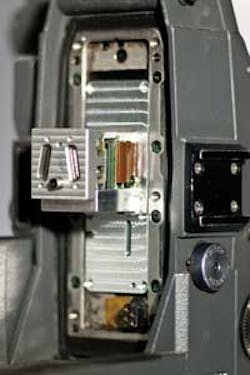IMAGE PROCESSING: Add-in modules turn film cameras digital
Before the advent of digital photography, most documentary film makers and television production organizations used 16-mm film cameras. Available with a range of lens options and accessories, cameras such as the AR3 16-mm film camera fromArri (Munich, Germany) became the workhorse of cinematographers worldwide. Indeed, numerous rental companies still stock these cameras for film and television production.
For companies such asEasylook System (Hamburg, Germany), the long legacy of 16-mm cameras and their accessories coupled with their relatively low cost and the trend toward digital imaging represent an opportunity. To preserve their investment in legacy 16-mm hardware while providing a film-to-digital replacement, the company has developed a system known as Easymag that converts film cameras such as the Arri SR3 and 416 into high-definition video cameras.
According to Gert Kappes, managing director of Easylook System, the Easymag system preserves the use of the cameras' optical viewfinder and standard Arri accessories such as portable batteries while leaving the mechanical design of the camera unchanged.
To transform these 16-mm cameras into digital high-definition systems, Easylook System replaced the original camera gate, placing an ACE acA2000, 2048 × 1088-pixel, 60-frame/s colorCamera Link camera from Basler (Ahrensburg, Germany) in the film plane of the camera (see figure). By synchronizing the camera's reflex mirror with the vertical retrace pulse of the Basler camera, digital high-resolution images can be captured.
However, since the camera supports a single Base Camera Link interface, it was necessary to perform preprocessing tasks on the images and then convert them into an HD-SDI output signal. To accomplish this task, Easylook turned toDream Chip Technologies (Garbsen, Germany) to develop a programmable interface converter.
This single-board converter, the Camaro-3G, performs a number of preprocessing functions on the Camera Link image data. These include Bayer color conversion and algorithms to adjust the RGB black level and white balance of the camera. A framing function performed in hardware can then be used to convert the 1920 × 1080 HD or the 2048 × 1088 2k images from the camera into the 1280 × 720 frames. After framing, the images are then converted to HD-SDI signals using the converter's on-board video timing generator.
In this way, the converter can output a number of HD-SDI output formats such as 1280 × 720 at 50 or 60 Hz and 1920 × 1080/2048 × 1088 formats at 24, 25, 30, 50, and 60 Hz. Embedded in the Easymag system, the HD-SDI output from this converter is then stored in compact flash cards or output as HD-SDI signals.
"Because the camera has the capability to operate at 340 frames/s," says Kappes, "refurbished digital Arri cameras that incorporate the Easymag system also have the capability to capture images at 340 frames/s for periods up to 20 s with a ring buffer. This makes such cameras especially useful in broadcast sports applications where high-speed photography may be required."
First shown at the VISION 2011 tradeshow in Stuttgart, Germany, the Camaro-3G interface board is also now being marketed by both Easylook and Dream Chip Technologies as a standalone product. For now the Camaro-3G is working with the Basler Aviator avA1900-60kc ELS and the ACE acA2000-340 ELS, but other cameras are possible. Interestingly, on the Dream Chip booth, the company also demonstrated a Camera Link to CoaXPress converter, a product that existing Camera Link developers may find extremely useful in transferring images from Camera Link cameras over very long distances.

